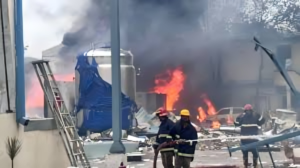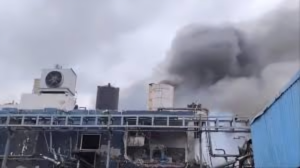A Devastating Chemical Explosion at a Telangana Pharma Factory Rocks Sangareddy District
Introduction
On Monday, June 30, 2025, a massive explosion ripped through the spray dryer unit of Sigachi Industries’ microcrystalline cellulose plant in the Pashamylaram industrial estate of Telangana’s Sangareddy district. The blast and ensuing fire reduced the factory building to rubble, trapping workers under twisted steel and concrete. As of July 1, officials have confirmed at least 36 fatalities, dozens injured, and many still unaccounted for in one of India’s deadliest recent industrial disasters.

The Sequence of Events
The explosion occurred around 2:15 PM local time in a spray dryer, a critical component used to convert raw chemical materials into fine pharmaceutical powders. Investigators believe intense pressure buildup and the presence of highly combustible particles triggered the detonation.
- Immediate impact:
- The entire production hall collapsed within seconds.
- A fireball and thick black smoke engulfed the premises.
- Emergency response:
- Eleven fire engines and specialized robotic units were deployed.
- National Disaster Response Force (NDRF) and State Disaster Response Force (SDRF) teams arrived within 20 minutes.
- Ongoing rescue:
- More than 140 employees were on-site; over 100 rushed to nearby hospitals.
- Debris-clearing operations continue around the clock.
Human Toll and Rescue Efforts
Officials recovered 34 charred bodies from the rubble, while two more succumbed to severe burns in hospital, bringing the confirmed death toll to 36. Nearly three dozen survivors are being treated for critical injuries including third‑degree burns and inhalation injuries. DNA forensics teams have been brought in to identify heavily burned victims, as many remains were beyond recognition.
Key figures
- Fatalities: 36 confirmed
- Injured: Approximately 40 admitted with serious burns and trauma
- Missing: At least 17 unaccounted for amid collapsed structures

Broader Implications for Industrial Safety
This tragedy has renewed scrutiny of India’s booming pharmaceutical sector, which supplies bricks and mortar of global drug supplies. Sigachi Industries suspended plant operations for 90 days and faces a state‑ordered safety audit across all chemical facilities.
- Regulatory response:
- Telangana Chief Minister A. Revanth Reddy announced a ₹1 crore ex‑gratia payment to each victim’s family.
- A high‑level probe panel to report causes and suggest safety reforms within three weeks.
- Industry concerns:
- Many factories operate under tight profit margins, sometimes at the cost of maintenance.
- Experts warn that aging equipment and lax enforcement can turn routine processes into deadly hazards.
Lessons and Preventive Measures
Preventing future industrial disasters requires a multi‑pronged approach:
- Rigorous safety audits:
- Regular third‑party inspections of high‑risk units (e.g., spray dryers, reactors).
- Upgraded infrastructure:
- Retrofitting older plants with modern pressure‑relief valves and automatic shut‑off systems.
- Worker training and drills:
- Mandatory emergency evacuation drills and proper personal protective equipment (PPE) protocols.
- Community awareness:
- Engaging nearby residents in risk‑reduction plans and early warning systems.

- Engaging nearby residents in risk‑reduction plans and early warning systems.
Conclusion
The Sangareddy blast serves as a grim reminder that rapid industrial growth must be matched with uncompromising safety measures. As investigations proceed and families mourn, stakeholders across government and industry must collaborate to strengthen safeguards, ensuring that no worker pays the ultimate price for corners cut in the name of productivity.